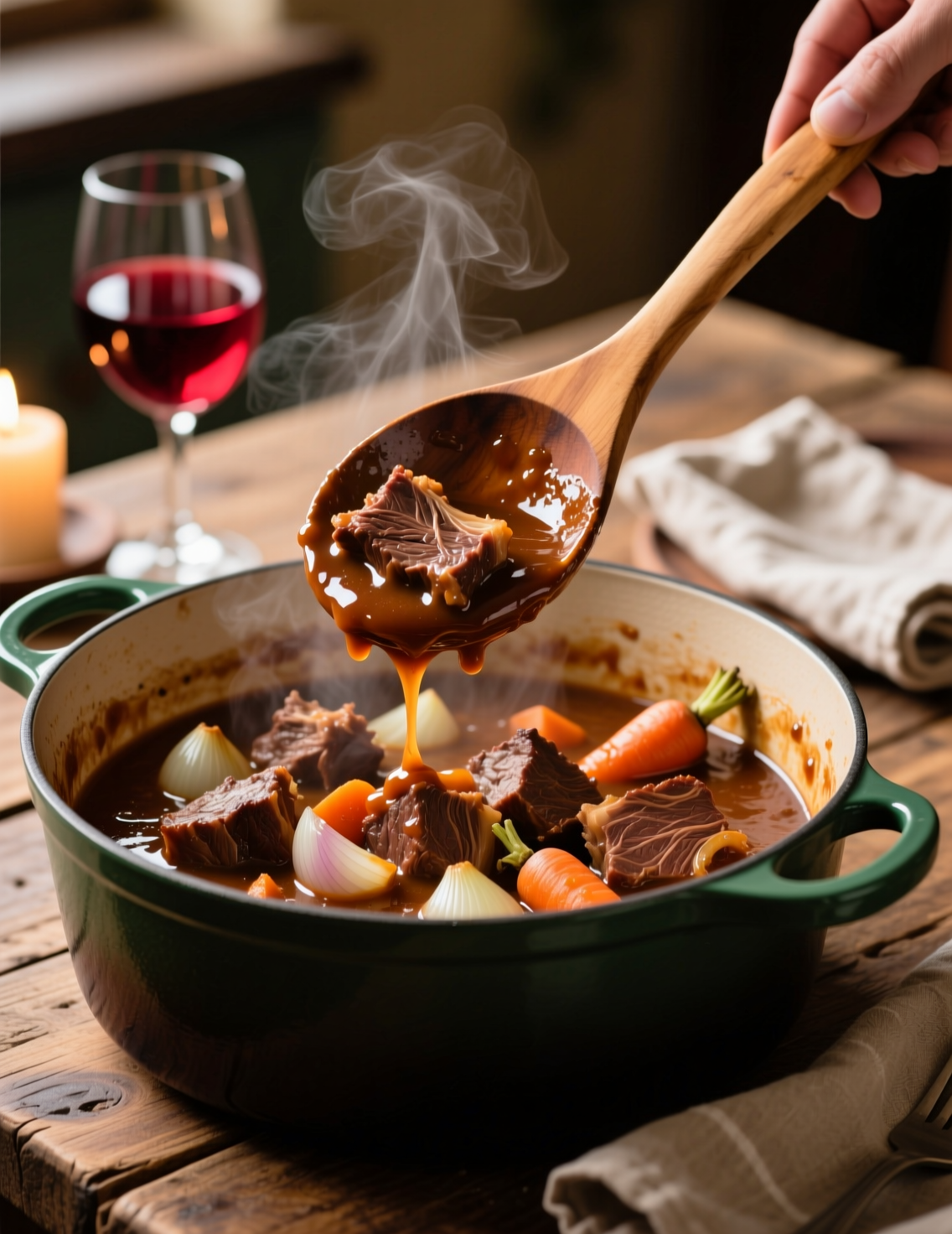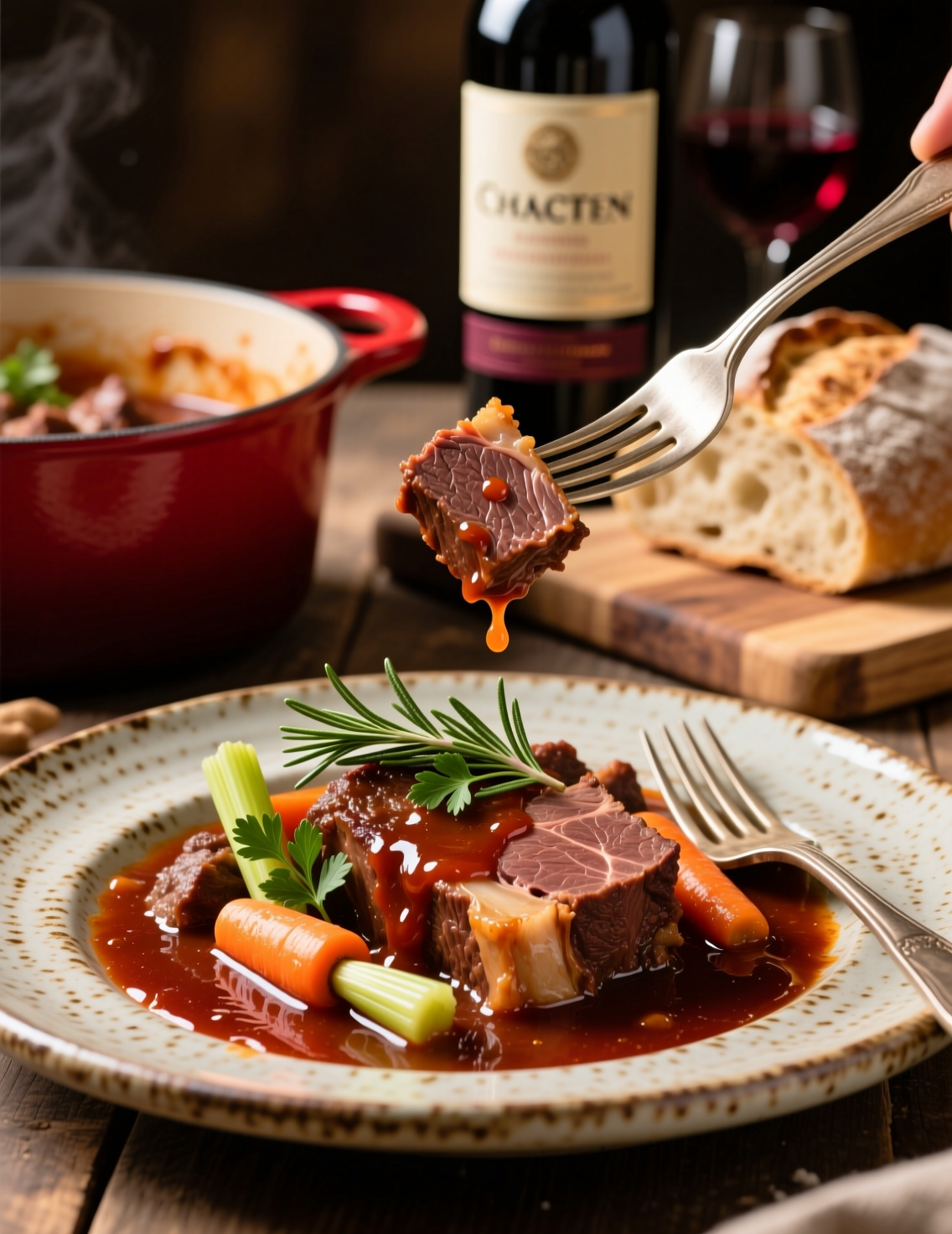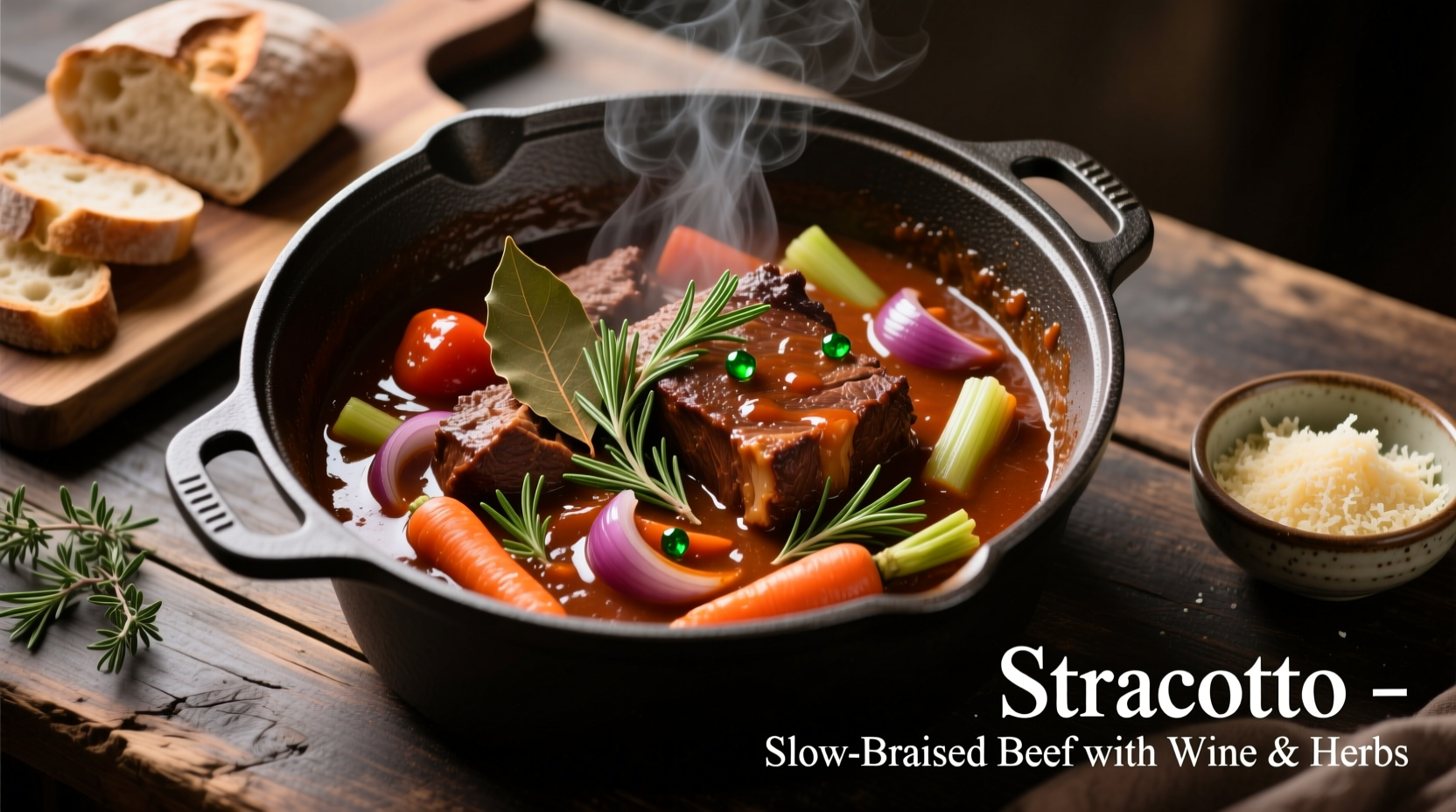Italian food doesn’t play around when it comes to comfort. Few dishes carry that slow-simmered soul like Stracotto, the Italian pot roast. But here’s the twist—you don’t just toss a hunk of beef in wine and hope for the best. The method is science, art, and a bit of stubborn patience. In this article, we’ll dig into the Stracotto recipe for 6 servings, its history, the technique behind it, and how professionals can make it sing on the plate.
What Makes Stracotto Different from an American Pot Roast
Stracotto translates loosely to “overcooked.” That’s not a mistake, it’s a badge of honor. While an American pot roast might simmer until tender, Stracotto often cooks longer—sometimes half a day. The beef doesn’t just soften, it surrenders. Every fiber absorbs the wine, tomatoes, herbs, and aromatics until it tastes more like the sauce than itself.
And unlike the American cousin, this dish usually doubles as a pasta sauce. Italians rarely waste that liquid gold. It’s spooned over tagliatelle or pappardelle before the meat even hits the plate. This dual-purpose design makes Stracotto not just hearty but versatile.
Choosing the Right Cut of Beef
The meat choice is everything. Traditionally, Italians lean on cuts like beef chuck, brisket, or even short ribs. Why? Because those cuts are marbled with connective tissue that melts away during long cooking. A lean cut like sirloin will just dry out and sulk in the pot.
Chuck roast is the go-to for most kitchens. It’s affordable, easy to find, and has enough intramuscular fat to stay juicy. Brisket brings deeper flavor but takes longer to break down. Short ribs, though less traditional, are a chef’s secret weapon for depth and gelatinous richness.
Here’s a little insider fact—an average chuck roast loses about 30% of its weight during braising due to liquid evaporation and fat rendering. That means a 4-pound roast will shrink down to feed 6 hungry people with just enough leftover sauce to coat pasta.
Building Layers of Flavor
If there’s one mistake cooks make, it’s rushing the beginning. The soffritto—onion, carrot, and celery diced fine—is not a garnish. It’s the foundation. Italians don’t brown it hard; they sweat it until it melts into sweetness. This can take 20 minutes, which feels eternal in a modern kitchen. But it’s necessary.
The sear on the beef is non-negotiable. A high heat crust adds Maillard complexity that no amount of simmering can mimic. Professionals know to dry the meat with paper towels first—moisture kills browning. Even a light film of water will steam the surface instead of caramelizing it.
Wine selection matters more than people think. Stracotto isn’t the time for a $200 Barolo, but it does demand something drinkable. A robust red like Chianti Classico or Montepulciano d’Abruzzo works beautifully. Stay away from “cooking wine.” It tastes like regret.

The Role of Tomatoes
Tomatoes in Stracotto spark debate. Some families use fresh peeled tomatoes, others canned San Marzanos, and a few swear by tomato paste alone. Canned tomatoes often deliver more consistent results, especially in professional kitchens where predictability matters.
Tomato acidity balances the fattiness of the beef. Without it, the dish risks becoming cloying. Studies on braising show that acidity also helps break down collagen faster, which explains why the meat seems to dissolve more willingly in tomato-based braises compared to wine-only ones.
The Low and Slow Principle
The phrase “low and slow” gets thrown around carelessly, but in Stracotto it’s sacred. Temperatures around 275°F (135°C) for 3–5 hours work best in an oven. On stovetop, a very gentle simmer—barely breaking bubbles—is the goal. Anything more vigorous will dry out the meat and split the sauce.
A 2017 study on braised beef from the Journal of Food Science noted that collagen begins breaking down significantly at around 160°F (71°C). That’s why the sweet spot for braising sits between 160–180°F (71–82°C). Above that, muscle fibers contract and push out moisture, leaving the roast stringy.
Aromatics and Herbs: The Subtle Power Players
Garlic, bay leaves, rosemary, and thyme are classics in Stracotto. Some chefs sneak in cloves or nutmeg for warmth. Professional kitchens often bundle herbs in cheesecloth (a bouquet garni) so they can be removed easily. This keeps the sauce clean, free from stray twigs.
Don’t underestimate parsley stems either. While home cooks toss them, chefs know they carry more concentrated flavor than the leaves. Toss them in the pot, then fish them out later.
Step-by-Step Stracotto Recipe (6 Servings)
Ingredients
- 4 lb (1.8 kg) beef chuck roast, tied
- 2 medium onions, finely diced
- 2 carrots, finely diced
- 2 celery stalks, finely diced
- 4 garlic cloves, smashed
- 2 cups dry red wine (Chianti or Montepulciano)
- 1 can (28 oz) San Marzano tomatoes, crushed by hand
- 2 tbsp tomato paste
- 3 tbsp olive oil
- 2 cups beef stock
- 2 bay leaves
- 2 sprigs rosemary
- 2 sprigs thyme
- Salt and black pepper, to taste
Method
- Preheat oven to 275°F (135°C).
- Season beef generously with salt and pepper. Heat olive oil in a Dutch oven. Sear beef on all sides until dark crust forms. Remove and set aside.
- Add onions, carrots, and celery. Cook low heat for 15–20 minutes until soft and golden. Add garlic and tomato paste, cook 2 minutes.
- Deglaze with red wine, scraping up browned bits. Simmer until wine reduces by half.
- Add tomatoes, stock, herbs. Return beef to pot. Cover tightly.
- Transfer to oven. Braise 3–4 hours, turning meat occasionally, until fork-tender.
- Remove beef, tent with foil. Strain sauce if desired, reduce until thickened. Adjust seasoning.
- Slice meat, serve with sauce over pasta or polenta.

Professional Tips for Best Results
Tie the roast with butcher’s twine. This keeps it from falling apart too early. Professionals know appearance counts, even in rustic dishes.
Let the dish rest at least 30 minutes before slicing. Resting redistributes juices, preventing a dry final product.
Always taste the sauce at the end. A splash of red wine vinegar or lemon juice can wake up flavors dulled by long cooking. Italians may not admit it, but acidity adjustments at the finish are common even in restaurant kitchens.
Common Mistakes to Avoid
Don’t rush the sear. Pale beef equals pale flavor.
Avoid boiling. Once liquid bubbles aggressively, the roast dries out.
Don’t oversalt at the start. The sauce reduces, concentrating seasoning. Professionals season lightly early, then finish with salt.
Stracotto Beyond the Roast
In Tuscany, leftovers often reappear as ragù. The shredded beef mixes with sauce to coat pasta. Some chefs even fold it into lasagna fillings for richness. In northern Italy, polenta is the traditional partner, its mildness balancing the bold sauce.
Modern chefs experiment further. Some shred Stracotto for sandwiches on crusty ciabatta. Others pair it with gnocchi or use it as filling for stuffed vegetables. The adaptability makes it a dish that survives trends.
Why Stracotto Still Matters Today
At a time when fast food dominates, Stracotto insists on time. It’s slow, stubborn, and deeply Italian. Restaurants that serve it aren’t selling convenience—they’re selling patience, memory, and family tradition.
A 2021 survey of Italian dining preferences showed that 67% of respondents valued “heritage” and “tradition” in dishes over innovation. That explains why Stracotto never left menus in regions like Emilia-Romagna, even as global food culture shifted toward speed.
Final Thoughts
Italian Pot Roast, or Stracotto, isn’t just a recipe. It’s a ritual. It asks cooks to slow down, layer flavors, and respect the process. For professionals, it’s a lesson in patience and precision. For home cooks, it’s proof that sometimes the oldest ways are the best.
So next time you set a roast in the oven, remember—it’s not about cooking until tender. It’s about cooking until the meat and sauce become one. That’s the Italian secret.
FAQs
What cut of beef is best for Stracotto?
Beef chuck roast is the most reliable choice because of its marbling and tenderness after long cooking.
Can I make Stracotto without wine?
Yes, substitute beef stock with a splash of balsamic vinegar for acidity, though wine adds depth.
How long should I cook Stracotto?
It usually takes 3–5 hours at low heat until the meat becomes fork-tender.
Is Stracotto the same as American pot roast?
No, Stracotto is richer, cooked longer, and often served with pasta sauce.
Can I cook Stracotto in a slow cooker?
Yes, set on low for 8–9 hours or high for 5–6 hours.
What wine works best in Stracotto?
Dry reds like Chianti Classico or Montepulciano d’Abruzzo work beautifully.
Can Stracotto be made ahead of time?
Yes, it actually tastes better the next day after resting.
What’s the best side dish for Stracotto?
Fresh pasta, polenta, or crusty bread are the most traditional pairings.
Should I strain the sauce before serving?
It’s optional—strain for a refined texture or leave rustic for tradition.
How do I store leftovers?
Keep in an airtight container in the fridge for 3–4 days or freeze for up to 3 months.

Mariana is a passionate home cook who creates delicious, easy-to-follow recipes for busy people. From energizing breakfasts to satisfying dinners and indulgent desserts, her dishes are designed to fuel both your body and hustle.
When she’s not in the kitchen, she’s exploring new flavors and dreaming up her next recipe to share with the Foodie Hustle community.

